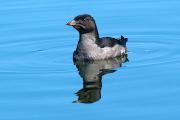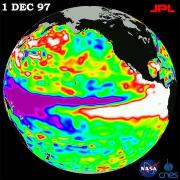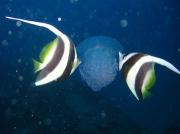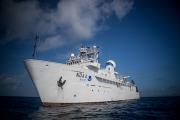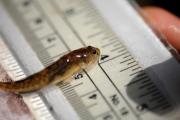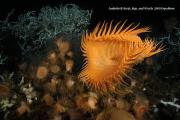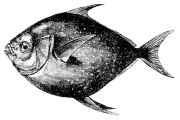Radio Program
Our regular Science and the SeaTM radio program presents marine science topics in an engaging two-minute story format. Our script writers gather ideas for the radio program from the University of Texas Marine Science Institute's researchers and from our very popular college class, Introduction to Oceanography, which we teach to hundreds of non-science majors at The University of Texas at Austin every year. Our radio programs are distributed at to commercial and public radio stations across the country.
In the history of the United States, Dwight Sigsbee is recorded as the captain of the U.S.S. Maine when the ship was sunk in Havana Harbor in 1898. The sinking triggered the Spanish-American War.
In the history of oceanography, though, Sigsbee is recorded across the bottom of the Gulf of Mexico. Because he led the first expedition to chart the Gulf floor, in the 1870s, he’s the namesake of several features. They’re all part of the deepest part of the Gulf -- a 300-mile-wide patch known as the Sigsbee Basin or Sigsbee Deep.
The rhinoceros auklet has a strong work ethic. The bird heads out to sea before dawn, spends the day hunting, and returns to its nest well after dark. Since predators can’t see the birds coming and going as well when it’s dark, that behavior may help the auklet protect its nest.
The rhinoceros auklet is found along the Pacific coasts of North America and northern Asia. In North America, most of them breed in cooler northern climates, then winter over in California.
Climate scientists in Asia noticed something odd about the summer of 2004. Droughts and heat waves overwhelmed a good bit of southeast Asia, most of Australia, and parts of the Americas. But it was especially wet in the Philippines, New Zealand, and Brazil. At the same time, scientists recorded unusual water temperatures in the Pacific Ocean.
Jellyfish are among the least-appetizing creatures in the oceans. And biologists have long assumed that even other sea creatures didn’t eat them. After all, 95 percent of the average jellyfish is nothing but water, so it doesn’t offer much actual food. And the “stingers” on many jellies can turn them from prey to predators.
A research vessel will be making some nice stops this year -- from South Carolina to Bermuda to the Azores. Between those ports of call, it’ll explore regions of the Atlantic Ocean that are largely uncharted. It’ll map the ocean floor, take a look at coral reefs, and study the water. And it’ll broadcast all of its work in real-time, allowing scientists around the world -- and all the rest of us, too -- to watch over its shoulder.
Marine biologists said “hello” to a new species of a tiny fish that lives on the California coast just a few years ago. Now, they’re trying not to say, “good bye.”
The tidewater goby is only a couple of inches long. And its mating rituals are the opposite of most fish. The male digs a burrow to house the eggs, then is “courted” by females, who exhibit colorful displays to attract potential mates.
A few million years ago, a handoff took place along the coast of northwestern Mexico. The strip of land that forms Baja Mexico was passed from one of the plates that make up Earth’s crust to another. The handoff created a gap between Baja and the present-day Mexican coast. The gap filled with water, forming the Gulf of California.
Corals aren’t limited to bright, warm tropical waters. As marine biologists are discovering, some corals can survive just as well with no sunlight at all, and in temperatures that can be near freezing. Yet these inhabitants of the cold depths are just as colorful as their warm-water cousins.
You never know what treats you’ll find at your local fish market. At a commercial fish auction market in Honolulu, for example, researchers recently found three new species of opah. The discovery shows that we still have a lot to learn about the creatures that live under the sea.
Jamaica Bay, on the southern edge of Long Island, is getting a little rough around the edges. Changes in the salt marshes around the bay have left them more vulnerable to erosion. That could expose the land behind them to more flooding as sea level gets higher. And it could damage the habitat of hundreds of species of birds, fish, and other creatures that live in and around the bay.


